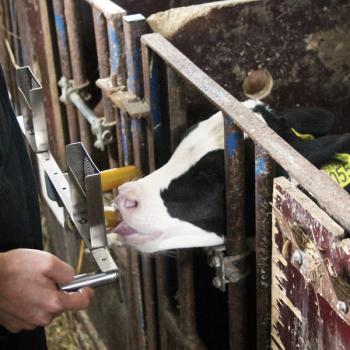Discussion & applications
Main conclusions & applications in the industry

The results of the present study show that the taste of glucose, but not the "Freshly Cut Grass" odor, had a significant effect on the calves' teat preference when suckling a dry artificial teat. More importantly, the results show that glucose significantly increased the motivation of calves to suckle a dry artificial teat, and that this motivation increased with age.
The animals in the present study required on average two to three days to become efficient in suckling without lifting assistance, and the use of glucose might be able to shorten this period by increasing suckling motivation in calves still learning to suckle from an artificial teat, as shown in the results regarding calves that were already efficient in the task. Glucose applied on the artificial teat may also be able to increase suckling motivation in calves that suckle efficiently but that require frequent stimulation of the suckling reflex from the staff in order to do so, or in calves that have low motivation to suckle due to illness. This, in turn, not only improves the welfare of the calves but may also benefit the dairy farmer's economy by decreasing the caretaker's workload when dealing with a number of newborn calves requiring assistance during feeding, and by potentially preventing undernutrition and weight loss in calves that have difficulty consuming a full milk meal without assistance.
Further research regarding the odor test
Newborn animals are able to become attracted to odors that are present on the skin of the mammary glands of the mother during suckling. In the case of an essential or fragrance oil used as the odor substance, such application on the udder could be achieved quickly, efficiently and economically in the form of spray or ointment. It would, thus, be useful to re-examine teat preference and suckling times in the odor test after having applied the "Freshly Cut Grass" odor or another odor that is presumably attractive on the udder of the dam shortly before labor and up until separation time from the calf.
Order of investigation in the taste test
Cattle are capable of distinguishing colors particularly between orange, yellow and red and can also differentiate items of various light intensities. It is, thus, likely that the calves visually distinguished between the orange-colored control teat and the white-colored (due to the glucose powder) modified teat used in the taste test. Assuming that the calves could visually distinguish between the two teats, it is possible that they preferred to investigate the control (orange) teat first due to its novelty, as the farm uses white-colored artificial teats when feeding the newborn calves. Another possible explanation would be that the calves initially avoided the glucose-coated teat due to food neophobia, which is the reluctance of sampling new foods for fear that they may be toxic or poisonous.
The importance of analyzing total suckling times
An important consideration when assessing suckling times per specific teat (control teat, modified teat) is the natural tendency of calves to switch between teats during suckling. When suckling the dam, the calf will suckle from more than one teat and rapidly switch between teats during a single feeding bout. Factors such as reduced milk flow and increased teat firmness can cause the calf to spend less time at a favored teat and switch to other available teats during a feeding bout. I, too, observed that the calves in the present study performed these switches between the two teats during the testing sessions, both in the odor and the taste test. Thus, I considered that it would be useful to examine if either the taste or the odor stimulus motivated the calves to suckle for a longer period of time in total during their testing sessions in comparison to the other stimulus. In accordance with the notion of de Passillé & Rushen (2006b) regarding the effect of sugars found in milk on the stimulation of non-nutritive suckling, my results demonstrate that the calves displayed a significantly increased motivation for non-nutritive suckling when presented with a sweet-tasting substance, than when presented with the "Freshly Cut Grass" odor.
Take-home message
The taste of glucose, but not the "Freshly Cut Grass" odor, had a significant effect on the calves' teat preference and significantly increased total suckling time with a dry artificial teat. Application of glucose on an artificial teat may increase suckling motivation in ill calves or non-efficient drinkers.
Responsible for this page:
Director of undergraduate studies Biology
Last updated:
05/15/17
